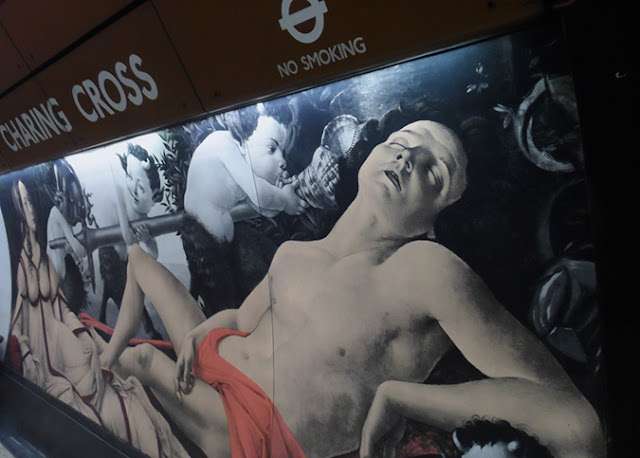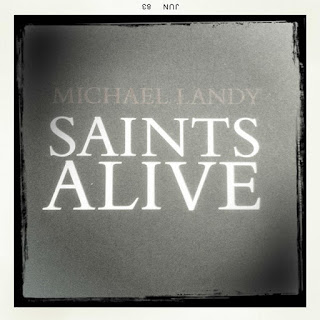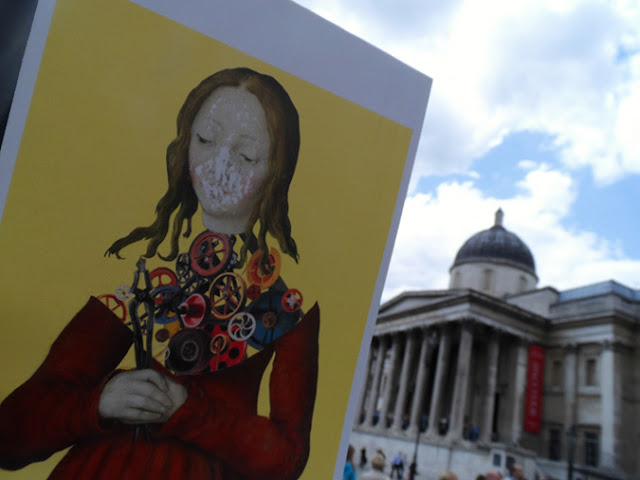From Kilburn to
Sainthood – Exploring London’s creative side
A persistent shade of blue is tearing apart London’s
notoriously grey skies and beckoning me out. A native Californian, even in
London I never go out without sunglasses. This garners me a welcome collection
of smiles from curious unshaded onlookers. A friendly “that’s all right dear,”
from a friendly passerby as I click photos of my neighborhood, a Britishism
applicable most anytime, forces me to respond with my own charmed smile. And
leads me to reflect on one of the reasons I love England so.
Everyone, from the twenty-year-old thug, the well adorned matron, tube attendant and construction worker at a neighborhood pub included will call you dear, love, and a whole host of other charming epithets without a trace of perversion or insinuation. It’s like everyone is your favorite Aunt Dottie…giving you a false sense of being appreciated and looked after.
Everyone, from the twenty-year-old thug, the well adorned matron, tube attendant and construction worker at a neighborhood pub included will call you dear, love, and a whole host of other charming epithets without a trace of perversion or insinuation. It’s like everyone is your favorite Aunt Dottie…giving you a false sense of being appreciated and looked after.
Neighborhood Plaque, the photograph that gets me a smile and a friendly
epithet. 25 June 2013
Continuing in my journey to the underground I am struck by
the architectural beauty of my neighborhood tube stop, built in 1915, it is one
of the more lovely stations in my humble opinion. Glazed in a deep merlot tile elegantly
adorning an art nouveau structure, it is my portal to London’s delights.
Kilburn Park Underground Station, 25 June 2013.
Plunging into the depths of London’s underground my blonde
tresses swirl riotously as if a shampoo commercial were on location, and in
this golden haze my train arrives to whisk me away to Central London.
Bakerloo Line train arriving at Kilburn Park Southbound platform, 25 June
2013
Alighting from the train at Charing Cross I am faced with
London’s love of art and culture. Papering the walls of the station are a
collection of artworks, Shakespearean quotes and portraits of luminaries in
England’s art world. I can feel Britain’s enthusiasm for art and culture
seeping through the very walls of its transport network.
Murals on
Bakerloo platform in Charing Cross underground station. 25 June 2013
As I emerge at Charing Cross the heavens have won their
battle against London’s grey fog and a bright blue sky greets me at Trafalgar
Square. Struck by the contrast of iron work against the bright atmosphere I
draw my camera and kneel upon the tube steps, the closest I've ever allowed
myself to the filthy well traveled stairway, but I’m rewarded with a stunning
burst of blue light.
Blue Skies warming the ironwork of Charing Cross entrance at Trafalgar
Square. 25 June 2013
Unsurprisingly I’m not the only Londoner, or tourist, drawn
out by the promise of warmth. The crowds of every persuasion litter the square
surrounding the National Gallery, an imminent museum whose foreboding façade
protects some of England’s greatest treasures, centuries of spectacular artwork
free and accessible to all. In an exceptional move to democratize art England
began funding a whole host of its major museums nationwide resulting in a
public attending with little more than an interest and a bit of free time. This
jewel of England’s crown has lured me in many times, but today I’m drawn by a
particular exhibit I’ve been waiting to see.
Program handout for Michael Landy “Saints Alive” exhibit at the National
Gallery
In a break from the traditional the National Gallery has
invited artist Michael Landy to populate a gallery with his incredibly unique
convergence of saints, collage and kinetics in a special exhibit titled “Saints
Alive.” Abstracting these saints from their faded histories and exploding them
in a new cultural consciousness, Landy reveals a new way to remember and
interact with these relics of history. Gone are the miniatures, the gold leaf,
the illumination. Hushed whispers have no space in a room echoing from the boom
of Landy’s kinetic sculpture depicting St Thomas’s finger crashing into
Christ’s scarred chest.
Print of Michael Landy’s work, “Saint Apollonia (de-faced)” backed by the
massive National Gallery.
The exhibition is divided spatially, beginning with Landy’s
evocative collage art, blending printed body parts of the Gallery’s expansive
saint collection with a complex symmetry of gears, cogs and wheels merging the
disfigured saints into cohesive, abstract bodies. The eye is soothed from a
Bosch-esque mutiny of color with the simplicity of a solid white background.
Likewise the surrealist re-imagined portraiture is absent the fluidity of Dali
by its stark edges, popping violent yet lonely from the negative space. It leaves me transfixed, and strangely lonely
yet creatively invigorated.
“Multi-Saint, 2” sketch from
postcard. 25 June 2013
Once my eyes have consumed as much detail, connection,
emotion and meaning as I can glean from Landry’s one-dimensional collages I
find my way into the kinetic gallery. I am instantly drawn from my museum
induced reverie by the booming thump of St Thomas’s index finger returning to
scrape away at Christ’s chest as a young tourist erupts in a fit of giggles
after compressing the sculpture’s mechanical pedal with her TOMs clad toe. Her
giggle, and surprise at the violent kinetic surrealism, is infectious,
dissolving any quiet cultured airs visitors may have as they join in with a
collective guffaw. I can’t but think Mr. Landy would be pleased. To surprise,
provoke, share, tease from the crowds a sense of unity is an art of its own.
These massive fiberglass sculptures, melding gears and wheels, old tricycles
and rusting springs with the larger than life features of self effacing saints
engaging visitors with concepts of sainthood and encourages each of us to seek
out the original inspirations found throughout the museum. I wonder at its
reception, its chaotic and almost violent defacing of saints to reimagine them
and recontextualize their martyrdom. I am moved, almost emotionally shattered,
by the imagery. And yet I struggle to understand what I find so touching in
Landy’s art. Perhaps simply my own aesthetic preference for collage or
contraption, but also a deep appreciation for an artist’s willingness to subvert
staid tradition to offer new ways to think of the world around, and behind, us.
Sketch of Saint Thomas pointing at Christ’s torso, from exhibit program. Actual
sculpture is easily 7-ft tall.
Leaving Mr. Landy’s world behind, juggling my residual
emotional inner dialogue, I re-emerge into the humid blue of London’s summer.
Wading through eager crowds I am rewarded with a classic view of Charing Cross,
British flag flying and a row of iconic red phone booths lined up like
attentive soldiers.
Charing Cross sprawling in Central London. 25 June 2013
Turning my compass towards Covent Garden for a spot of tea, some
ideal people watching, and continued reflection on the joys of London’s free
and accessible artworks, I find solace from the masses with the most classic of
English pastimes. A pot of tea, Earl Grey, one sugar and a splash of milk.
Perfection!
Pot of Earl Grey tea at Café Nero, Covent Garden. 25 June 2013.
Have a gallery, museum or neighborhood in London you love,
or would love to see? Comment below with your thoughts and perhaps I’ll choose
your suggestion for my next outing and future blog post. You can also tweet
your suggestions to @Rose_M_Bell and @FilmRobin.
Cheers!
Please visit: Twitter: @FilmRobin for up-to-date info on where I am travelling for ART. LinkedIn: LinkedIn.com/in/robinscottpeters for complete resume & work history. Smashwords.com and look for Dr. Robin Scott Peters Ebooks now available. YouTube: Youtube.com/user/robinscottpeters for all my video work.















No comments:
Post a Comment